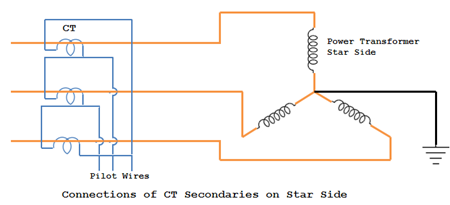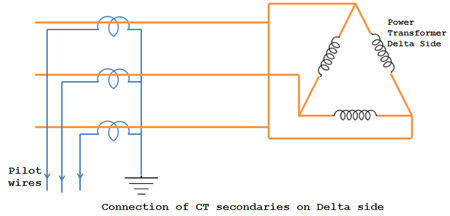
Merz Price or differential protection is crucial to protect power transformers from failure and possible damage. Because transformers play an important role in electrical power systems, it is critical to ensure their reliable operation and protect them from harmful conditions. The Merz Price differential protection scheme provides an effective solution by comparing the currents entering and leaving the transformer windings. In this article, we will look at the specifics of Merz Price or differential protection. We will discuss its working principle, components and how it is used to protect power transformers. By understanding this essential protection mechanism, engineers and professionals in the electrical industry can ensure the safe and efficient operation of power transformers, contributing to the stability and reliability of electrical power systems.
Merz price protection for power transformers
Merz Prize The circulating current principle is often used to protect Power transformers of 5MVA and more against Earth and phase errors The system applied to transformers is basically the same as that applied to generators, but it has certain complicated features that are in the Generator Protection System . They are explained below;
TC reasons
In a power transformer, the currents in the primary and secondary windings must be compared. These currents are different due to different primary and secondary voltages. The difference is therefore compensated by the different number of turns in the current transformers. If N is the number of turns of the power transformer, then the number of turns of the low voltage side current transformers is N times greater than that of the high voltage side current transformers. In this state, the secondary windings of the two current transformers carry identical currents under normal conditions. As a result, no differential current flows through the relay, so it remains inoperative.
CT Connections
There is normally a phase difference between the primary and secondary currents of a three-phase power transformer. Even when current transformers with the correct turns ratio are used, appropriate current transformer connections create a differential connection for the phase difference. The current transformers on one side of the transformer are connected so that the resultant currents fed into the pilot lines are phase-shifted from the individual phase currents in the same direction and by an angle equal to the phase shift between the primary and secondary currents of the power transformer.
-
Read: Leakage Reactance of Central Transformers
-
Read: Transformer Cooling Methods
Power transformers are grouped according to the phase changes listed below (as per IS 2026-1962) .
Group 1: Star-star Phase change = 0 Ó
Group 2: Star-star Phase shift = 180 Ó
Group 3: Delta star Phase shift = -30 Ó
Group 4: Delta star Phase change = +30 Ó
To phase the currents on both sides of the CT (TC sides on HV and LV side), the following rules are followed.
The secondary windings of the current transformers on the connection side of the power transformer are connected in delta connection, as shown in the following figure:

The secondary current transformers on the delta side of the power transformer are connected as shown in the following figure.

With such an arrangement, the phase shift between the currents is canceled out by the phase shift due to the secondary wind.
The table below shows the type of connections that CTs use to make the phase difference in the transformer's primary and secondary currents.
| S. No | Power transformer connection | Current transformer connection | ||
| Primary | Secondary | Primary | Secondary | |
| 1 | Star (grounded in neutral) | delta | delta | star |
| two | delta | delta | star | star |
| 3 | star | Star (grounded in neutral) | delta | delta |
| 4 | delta | Star (grounded in neutral) | star | delta |
Merz-Preis differential protection for delta-delta power transformer
For delta/star power transformer the current transformers on the delta side must be connected to the star and the current transformers connected in delta on the star side.
The figure shows Merz Preis differential protection for three-phase delta/delta power transformer . The current transformers on both sides are connected in a star shape. This equalizes the phase difference between the primary and secondary currents of the power transformer. Current transformers are connected via pilot wires and a relay is used for each pair.
Under normal conditions, that is, without failures, the secondary windings of current transformers carry identical currents. Therefore, the winds entering and leaving the pilot wires at both ends are equal and no current flows through (OC) the relays. When a ground fault or a phase-to-phase fault occurs, the currents in the secondary winding of the current transformer are no longer the same, and the differential current flowing through the relay circuit causes the circuit breakers on both sides of the transformer to trip. power trip.
This scheme also protects against short circuits between turns of the same phase winding. When a short circuit occurs between the turns, the turns ratio of the power transformer is changed, resulting in an imbalance in the power transformer pairs. When sufficient differential current flows through the relay, it activates and clears the fault.
Conclusion
In short, Merz Price or differential protection ensures the safe and reliable operation of power transformers. By continuously monitoring the currents entering and leaving the transformer windings, this protection system can detect even the smallest faults or anomalies in the system. By quickly identifying and isolating faults, further damage to the transformer can be prevented and interruptions to the power grid can be minimized. Due to its effectiveness and reliability, Merz Price differential protection technology has been widely adopted in various power systems and industrial applications. As technology advances, new advances in differential protection can provide improved features and capabilities. However, the Merz Price method continues to be a cornerstone in the protection of power transformers and contributes to the stability and efficiency of electrical grids around the world.

